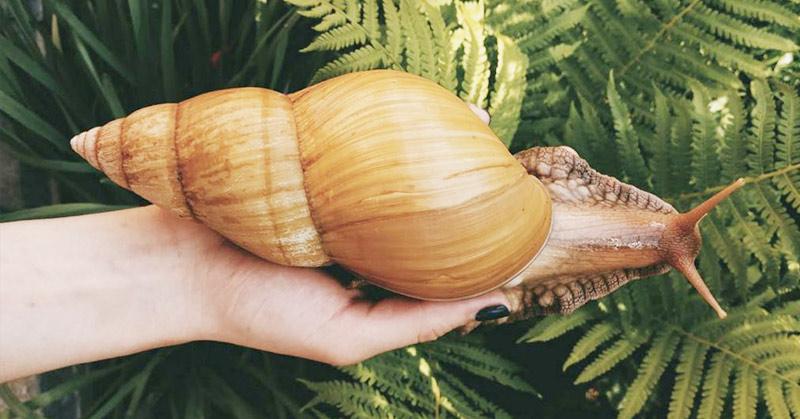Snails are adorable (most of the time). How can you not love those pouty, pursed lips and antenna eyes? What they lack in speed they make up for in cuteness, and there’s nothing more hilarious than watching a snail eat lettuce and cucumbers. Well, only if it’s a small, harmless, and clean snail. Ok so their cuteness is subjective, but you see what I’m saying.
Snails have always been variably sized. Some are as tiny as peanuts while others are as large as ping-pong balls. However, if you didn’t know snails could be as large as little dogs, you’re in or a shock. The larger the size, the less cute they become.
The Giant African Land Snail (Achatina fulica) can grow as long as 20 cm (7.9 inches), as high as 7 cm (2.8 inches) and can live as long a 5 -7 years. These gastropods are native to East Africa, mostly Kenya, Tanzania, Rwanda, and Uganda. They are also found in Asia, mostly in China, Bangladesh, India, Fiji, and then in some Pacific Islands, the Caribbean, and a lot of South America.
An adult snail weighs about 32 grams and may grow bigger, depending on their diet – which is nearly every plant you can think of. These snails are not selective and are comfortable eating living or dead plant matter. It’s no wonder why they are a serious problem for agriculture.
Dangerously Invasive species
The size and voracity of these species have led to their being classified as an invasive parasite-carrying species, and in many places, they are either banned or regulated [1]. In the United States, Canada, and Australia, it’s completely illegal to own a Giant African Land Snail.
Along with the yellow ant and brown stink bug, these snails have a spot on the IUCN’s list of 100 most invasive alien species, and they are so resilient it’s nearly impossible to get rid of them [2]. The snails have no natural predators and can lay 5 – 6 clutches per year, with an average of 200 eggs per clutch. They can quickly become vermin if they are not regulated.
The Giant African Land Snail is an intermediate host for several parasites including Schistosoma manson, Aelurostrongylus abstrusus, and Angiostrongylus cantonensis, among others. This is why Schistosomiasis is also called snail fever. This is a disease caused by parasitic flatworms affecting the urinary tract. It can result in bloody diarrhea, bloody urine, and severe abdominal pain.
They also transmit harmful parasites to other animals and plants and have an appetite for almost any kind of crop.
Invading Latin America
In many South American countries such as Brazil and Argentina, the snails have shown a promising future for escargot farming (heliciculture), the practice of raising snails for medication or consumption. The snails ‘trial’ has been used for a moisturizing face cream used in many Latin American countries. However, they’ve remained a huge threat to agriculture and must be controlled.
In Argentina, Colombia, and Venezuela, the governments have drafted plans to study the snails and restrict their prevalence to protect citizens from the health risks they pose [3]. In Colombia, 42 people have been reported dead from exposure to disease-carrying snails.
Smuggling the snails as pets – A risky venture creeping through the United States
The snails were thought to have vanished from the U.S. in 1975, but they made a shocking comeback in 2011 and are “rapidly” creeping through the country again, mostly through Florida [4]. They are not a pretty sight and some people have chosen to take them as pets, exposing their homes, children, and other pets to serious risk from the diseases these snails carry.
They are illegally smuggled into the country, mostly by tourists who do not understand how dangerous the species are. Keeping the snails as pets would not only freak out your neighbors and visitors, but you’re putting your entire home in great danger. For starters, they can crawl all over your vegetables and food items, transmitting dangerous parasites and nematodes that you do not want to ingest.
They can also begin to eat parts of your home when they are hungry, and if they are ever exposed to your garden or potted plants, the rest is history.
These animals are hermaphroditic, although they prefer to mate the traditional way. However, when there’s a shortage of reproductive partners, they can easy self-fertilize and lay a few hundred eggs in a hidden spot. How do you handle over 200 fast-growing baby snails?
The Department of Agriculture in Florida and the USDA are warning people to desist from bringing these snails back home. They could earn you a fine or a prison sentence, and who would want to be imprisoned because of a giant, slimy snail?
Sources
- Admin. Giant African Land Snail. Snail-world. https://www.snail-world.com/african-giant-snail/. Retrieved 10-01-2020
- GLOBAL INVASIVE SPECIES DATABASE. IUCN. https://www.iucngisd.org/gisd/species.php?sc=64. Retrieved 10-01-2020
- Admin. Giant African land snails are invading Latin America. Latin American Science. https://latinamericanscience.org/2013/08/giant-african-land-snails-are-invading-latin-america/. Retrieved 10-01-2020
- Admin. People Are Buying These Pet Snails That Are The Size Of Small Dogs. Jumble Joy. https://www.jumblejoy.com/dutch-inventor-confirms-ocean-clean-working-great-2. Retrieved 10-01-2020

